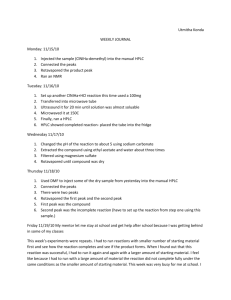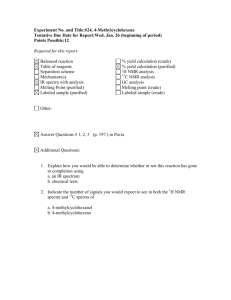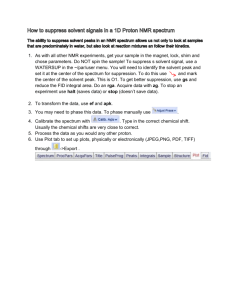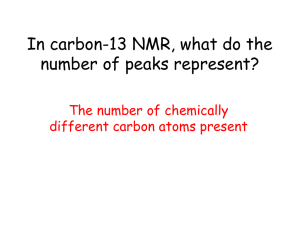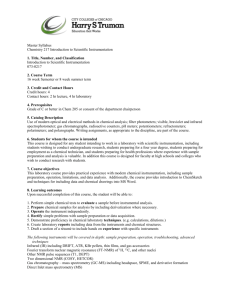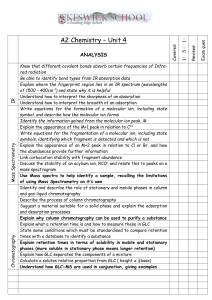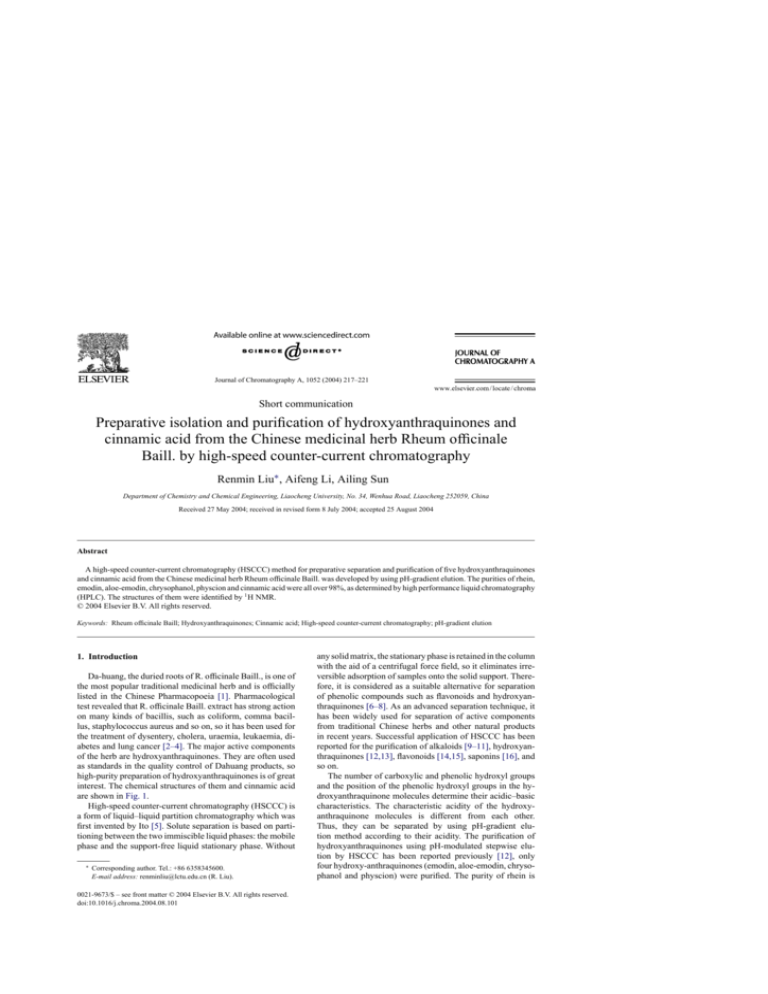
Journal of Chromatography A, 1052 (2004) 217–221
Short communication
Preparative isolation and purification of hydroxyanthraquinones and
cinnamic acid from the Chinese medicinal herb Rheum officinale
Baill. by high-speed counter-current chromatography
Renmin Liu∗ , Aifeng Li, Ailing Sun
Department of Chemistry and Chemical Engineering, Liaocheng University, No. 34, Wenhua Road, Liaocheng 252059, China
Received 27 May 2004; received in revised form 8 July 2004; accepted 25 August 2004
Abstract
A high-speed counter-current chromatography (HSCCC) method for preparative separation and purification of five hydroxyanthraquinones
and cinnamic acid from the Chinese medicinal herb Rheum officinale Baill. was developed by using pH-gradient elution. The purities of rhein,
emodin, aloe-emodin, chrysophanol, physcion and cinnamic acid were all over 98%, as determined by high performance liquid chromatography
(HPLC). The structures of them were identified by 1 H NMR.
© 2004 Elsevier B.V. All rights reserved.
Keywords: Rheum officinale Baill; Hydroxyanthraquinones; Cinnamic acid; High-speed counter-current chromatography; pH-gradient elution
1. Introduction
Da-huang, the duried roots of R. officinale Baill., is one of
the most popular traditional medicinal herb and is officially
listed in the Chinese Pharmacopoeia [1]. Pharmacological
test revealed that R. officinale Baill. extract has strong action
on many kinds of bacillis, such as coliform, comma bacillus, staphylococcus aureus and so on, so it has been used for
the treatment of dysentery, cholera, uraemia, leukaemia, diabetes and lung cancer [2–4]. The major active components
of the herb are hydroxyanthraquinones. They are often used
as standards in the quality control of Dahuang products, so
high-purity preparation of hydroxyanthraquinones is of great
interest. The chemical structures of them and cinnamic acid
are shown in Fig. 1.
High-speed counter-current chromatography (HSCCC) is
a form of liquid–liquid partition chromatography which was
first invented by Ito [5]. Solute separation is based on partitioning between the two immiscible liquid phases: the mobile
phase and the support-free liquid stationary phase. Without
∗
Corresponding author. Tel.: +86 6358345600.
E-mail address: renminliu@lctu.edu.cn (R. Liu).
0021-9673/$ – see front matter © 2004 Elsevier B.V. All rights reserved.
doi:10.1016/j.chroma.2004.08.101
any solid matrix, the stationary phase is retained in the column
with the aid of a centrifugal force field, so it eliminates irreversible adsorption of samples onto the solid support. Therefore, it is considered as a suitable alternative for separation
of phenolic compounds such as flavonoids and hydroxyanthraquinones [6–8]. As an advanced separation technique, it
has been widely used for separation of active components
from traditional Chinese herbs and other natural products
in recent years. Successful application of HSCCC has been
reported for the purification of alkaloids [9–11], hydroxyanthraquinones [12,13], flavonoids [14,15], saponins [16], and
so on.
The number of carboxylic and phenolic hydroxyl groups
and the position of the phenolic hydroxyl groups in the hydroxyanthraquinone molecules determine their acidic–basic
characteristics. The characteristic acidity of the hydroxyanthraquinone molecules is different from each other.
Thus, they can be separated by using pH-gradient elution method according to their acidity. The purification of
hydroxyanthraquinones using pH-modulated stepwise elution by HSCCC has been reported previously [12], only
four hydroxy-anthraquinones (emodin, aloe-emodin, chrysophanol and physcion) were purified. The purity of rhein is
218
R. Liu et al. / J. Chromatogr. A 1052 (2004) 217–221
Factory, Jinan, China). Methanol used for HPLC was chromatographic grade (Yucheng Chemical Factory, Yucheng,
China), and water used was distilled water.
The dried roots of R. officinale Baill. were purchased from
a local drug store and identified by Professor Yongqing Zhang
(Shandong University of Traditional Chinese Medicine, Jinan, China).
2.3. Preparation of crude sample
Fig. 1. Chemical structures of hydroxyanthraquinones and cinnamic acid
from R. officinale Baill.
very low. In the present study, the continuous pH-gradient
elution was employed in HSCCC. The optimum conditions
were obtained, which led to successful preparation of five
hydroxyanthraquinones and cinnamic acid from crude extract of R. officinale Baill.
2. Experimental
Preparation of crude sample was carried out according
to the literature [17]. The dried roots of R. officinale Baill.
were ground to powder (about 30 mesh). The powder (50 g)
was extracted with the mixture of 20% H2 SO4 and benzene
(1:5, v/v) for 1.5 h four times at 81 ◦ C (200 mL each time).
The benzene extracts were combined and evaporated under
reduced pressure to about 200 mL. Then the extract was extracted with 5% NaOH three times (200 mL each time). The
aqueous solution was acidified with 36% HCl to pH 2, and
then extracted with aether three times (200 mL each time).
The aether extracts were evaporated to dryness. A 1.2 g of
crude extract was obtained. It was stored in a refrigerator
(4 ◦ C) for further use.
2.1. Apparatus
The HSCCC instrument employed in the present study
is TBE-300A high-speed counter-current chromatography
(Tauto Biotechnique Company, Shanghai, China) with three
multilayer coil separation column connected in series (i.d.
of the tubing = 1.6 mm, total volume = 260 mL) and a
20 mL sample loop. The revolution radius was 5 cm, and
the β values of the multilayer coil varied from 0.5 at internal terminal to 0.8 at the external terminal. The revolution speed of the apparatus can be regulated with a speed
controller in the range between 0 and 1000 rpm. An HX
1050 constant-temperature circulating implement (Beijing
Boyikang Lab Instrument Co. Ltd., Beijing, China) was
used to control the separation temperature. An ÄKTA prime
(Amersham Pharmacia Biotechnique Group, Sweden) was
used to pump the two-phase solvent system and perform the
UV absorbance measurement. It contains a switch valve and
a mixer, which were used for gradient formation. The data
were collected with Sepu 3000 chromatography workstation
(Hangzhou Puhui Science Apparatus Co. Ltd., Hangzhou,
China).
The HPLC equipment used was Agilent 1100 HPLC system including a G1311A QuatPump, a G1315B DAD, a
Rheodyne 7725i injection valve with a 20 L loop, a G1332A
degasser and Agilent HPLC workstation.
Nuclear magnetic resonance (NMR) spectrometer used
here was Mercury Plus 400 NMR (Varian Inc., America).
2.2. Reagents
All solvents used for preparation of crude sample and
HSCCC separation were of analytical grade (Jinan Reagent
2.4. Preparation of two phase solvent system and
sample solutions
One percent NaH2 PO4 and 1% NaOH solutions were prepared by dissolving suitable amount of NaH2 PO4 and NaOH
in water and then saturated with aether, respectively. Aether
saturated with 1% NaH2 PO4 was used as the stationary phase.
The three kinds of solvent were degassed by sonication for
30 min prior to use.
The sample solutions were prepared by dissolving 120 mg
of crude extracts in 20 mL of the stationary phase.
2.5. HSCCC separation procedure
HSCCC was performed as follows: aether and 1%
NaH2 PO4 were pumped into the separation column simultaneously by ÄKTA prime with the volume ratio of 40:60,
which was controlled by the switch valve. After the column
was totally filled with two phases, the HSCCC apparatus was
revolved at a speed of 800 rpm while only 1% NaH2 PO4 was
pumped into the column at a flow rate of 2 mL min−1 . Half an
hour later, hydrodynamic equilibrium was reached. Then the
sample solution (120 mg of crude extract dissolved in 20 mL
of aether) was injected into the column through the injection
valve. At the same time 1% NaH2 PO4 and 1% NaOH were
pumped into the column simultaneously, and the linear gradient elution was started by changing the volume ratio of 1%
NaH2 PO4 and 1% NaOH. The volume ratio of 1% NaH2 PO4
and 1% NaOH was continuously changed from 100:0–0:100
in 500 min. The separation temperature was controlled at
25 ◦ C. The effluent from the tail end of the column was monitored at 254 nm. The chromatogram was recorded 80 min
R. Liu et al. / J. Chromatogr. A 1052 (2004) 217–221
after sample injection. Different fractions were collected according to the obtained chromatogram. Each fraction was
first acidified with 10% HCl to pH 2, and then extracted with
aether.
2.6. HPLC analysis and identification of HSCCC peak
fractions
The HPLC analysis of R. officinale Baill. crude extract and
HSCCC peak fractions was performed with a SPHERIGEL
ODS C18 column (250 mm × 4.6 mm i.d., 5 m) at room temperature. The mobile phase was methanol and 0.1% H3 PO4 in
gradient mode as follows: 0–3 min, 57% methanol; 3–20 min,
57–90% methanol; 20–40 min, 90% methanol. The effluent was monitored at 254 nm and the flow rate was kept at
1.0 ml min−1 constantly.
Identification of HSCCC peak fractions was carried out
by 1 HNMR. 1 H NMR spectrum was recorded on a Mercury
Plus 400 NMR with TMS as internal standard.
3. Results and discussion
3.1. Optimization of HPLC method
Different kinds of solvent system were used as the mobile
phase and different elution modes were employed to analyze
crude extracts from R. officinale Baill. by HPLC. The results
indicated that when methanol and 0.1% H3 PO4 were used as
the mobile phase in gradient mode (methanol: 0–3 min, 57%;
3–20 min, 57–90%; 20–40 min, 90%), six major peaks can
be obtained, and each peak got baseline separation. The peak
purity of HPLC was analyzed with Agilent 1100 workstation.
The results were satisfactory. HPLC chromatogram of crude
extract from R. officinale Baill. was given in Fig. 2(A).
3.2. Optimization of HSCCC conditions
With phenolic hydroxyl groups in molecule, hydroxyanthraquinone is a kind of acid compound. The characteristic
acidity of these compounds is determined by the number of
carboxylic and phenolic hydroxyl groups as well as the position of the phenolic hydroxyl groups in the molecules. The
solubility of them in the solutions with different pH is different from one another. So they can be separated by changing
pH value of the mobile phase of HSCCC. A continuous pHgradient elution mode was employed in this study. A more
subtle pH gradient zone and high resolution of HSCCC can
be obtained by this method.
The influences of the components of the stationary phase,
the concentration of NaH2 PO4 and NaOH, and the gradient elution time on the separation of hydroxyanthraquinones
from R. officinale Baill. by HSCCC were investigated. Good
separation results can be obtained when aether was used as
the stationary phase, and 1% NaH2 PO4 and 1% NaOH as the
mobile phase in gradient elution mode (1% NaH2 PO4 :1%
219
NaOH = 100:0–0:100 in 500 min). Under the optimum conditions, six major peaks can be obtained and yielded 19 mg
of peak I, 19 mg of peak II, 18 mg of peak III, 14 mg of peak
IV, 10 mg of peak V, and 6 mg of peak VI from 120 mg of
crude extracts. HSCCC chromatogram of crude extracts from
R. officinale Baill. was shown in Fig. 3.
3.3. Results of HPLC analysis and identification of each
HSCCC fraction
Each fraction of HSCCC was analyzed by HPLC. The purity of each fraction was over 98%. HPLC chromatogram
of the purified HSCCC peak fractions was shown in
Fig. 2(B–G).
Identification of each HSCCC fraction was carried out by
1 H NMR and 13 C NMR. each fraction were given as follows:
1 H NMR data of HSCCC peak I in Fig. 3: 1 H NMR
(400 MHz, DMSO): 12.03 (1H, s, C1 –OH), 11.91 (1H, s,
C8 –OH), 10.53 (1H, broad, –COOH), 8.08(1H, s, C2 –H),
7.38 (1H, d, J = 8.5 Hz, C5 –H), 7.71 (1H, m, C6 –H), 7.78
(1H, s, C4 –H), 7.81(1H, d, J = 7.5 Hz, C7 –H). Compared
with the data given in ref. [18], peak I corresponded to rhein.
1 H NMR data of HSCCC peak II in Fig. 3: 1 H NMR
(400 MHz, C2 HCl3 ): 11.01(1H, broad, –COOH), 7.81 (1H,
d, J = 16 Hz, C7 –H), 7.57(2H, m, C2 –H, C6 –H), 7.42 (3H, m,
C3 –H, C4 –H and C5 –H), 6.47 (1H, d, J = 16 Hz, C8 –H). 13 C
NMR (400 MHz, C2 HCl3 ) data of peak II: 172.06 (–COOH),
147.11 (C7 ), 133.99 (C1 ), 130.77 (C4 ), 128.96 (C3 , C5 ),
128.37 (C2 , C6 ), 117.17 (C8 ). According to 1 H NMR and
13 C NMR data, peak II was identified as cinnamic acid.
1 H NMR data of HSCCC peak III in Fig. 3: 1 H NMR
(400 MHz, C2 HCl3 ): 12.80 (1H, s, C3 –OH), 12.30 (1H, s,
C1 –OH), 12.12 (1H, s, C8 –OH), 7.63 (1H, s, C5 –H), 7.29
(1H, d, J = 2.4 Hz, C4 –H), 7.10 (1H, s, C7 –H), 6.68 (1H, d, J
= 2.4 Hz, C2 –H), 2.46 (3H, s, CH3 ). Compared with the data
given in ref. [18], peak III corresponded to emodin.
1 H NMR data of HSCCC peak IV in Fig. 3: 1 H NMR
(400 MHz, C2 HCl3 ): 12.12 (1H, s, C1 –OH), 12.11(1H, s,
C8 –OH), 7.86 (1H, d, J = 7.2 Hz, C5 –H), 7.81 (1H, s, C4 –H),
7.70 (1H, m, C6 –H), 7.37 (1H, s, C2 –H), 7.32 (1H, d, J =
8.4 Hz, C7 –H), 5.35 (1H, s, –CH2 –OH), 4.85 (2H, s, –CH2 –).
Compared with the data given in ref. [18], peak IV corresponded to aloe-emodin.
1 H NMR data of HSCCC peak V in Fig. 3: 1 H NMR
(400 MHz, C2 HCl3 ): 12.14 (1H, s, C1 –OH), 12.03 (1H, s,
C8 –OH), 7.83 (1H, d, J = 7.2 Hz, C5 –H), 7.68 (1H, m, C6 –H),
7.66 (1H, s, C4 –H), 7.30 (1H, d, J = 8.4 Hz, C7 –H), 7.11(1H,
s, C2 –H), 2.47 (3H, s, –CH3 ). Compared with the data given
in ref. [18], peak V corresponded to chrysophanol.
1 H NMR data of HSCCC peak VI in Fig. 3: 1 H NMR
(400 MHz, C2 HCl3 ): 12.34 (1H, s, C1 –OH), 12.14 (1H, s,
C8 –OH), 7.64 (1H, s, C5 –H), 7.38 (1H, d, J = 2.4 Hz, C4 –H),
7.10 (1H, s, C7 –H), 6.70 (1H, d, J = 2.4 Hz, C2 –H), 3.95
(3H, s, –OCH3 ), 2.46 (3H, s, –CH3 ). Compared with the data
given in ref. [18], peak VI corresponded to physcion.
220
R. Liu et al. / J. Chromatogr. A 1052 (2004) 217–221
Fig. 2. HPLC chromatogram of crude extract from R. officinale Baill. and HSCCC peak fractions. Column: a SPHERIGEL ODS C18 column (250 mm ×
4.6 mm i.d., 5 m); mobile phase: methanol and 0.1% H3 PO4 in gradient mode (methanol: 0–3 min, 57%; 3–20 min, 57–90%; 20–40 min, 90%); flow rate:
1.0 mL min−1 ; detection wavelength: 254 nm; (A) crude extract from R. officinale Baill; (B) peak I; (C) peak II; (D) peak III; (E) peak IV; (F) peak V; (G) peak
VI of Fig. 3.
R. Liu et al. / J. Chromatogr. A 1052 (2004) 217–221
221
efficient way for separation of five hydroxyanthraquinones
and cinnamic acid from R. officinale Baill.
Acknowledgement
Jichun Cui was greatly acknowledged for his help in structure identification.
References
Fig. 2. (Continued ).
Fig. 3. HSCCC chromatogram of crude extract from R. officinale Baill. Stationary phase: aether; mobile phase: 1% NaH2 PO4 and 1% NaOH to perform
pH-gradient elution (1% NaH2 PO4 :1% NaOH = 100:0–0:100 in 500 min);
flow rate: 2.0 mL min−1 ; revolution speed: 800 rpm; sample size: 120 mg
crude extract dissolved in 20 mL of aether; temperature: 25 ◦ C; retention
of the stationary phase: 40%. I: Rhein; II: cinnamic acid; III: emodin; IV:
aloe-emodin; V: chrysophanol; VI: physcion.
In conclusion, the result of our studies clearly demonstrated that continuous pH-gradient elution method was an
[1] China Pharmacopoeia Committee, Pharmacopoeia of the People’s
Republic of China, The First Division of 2000 Edition, China Chemical Industry Press, Beijing, 1999, p. 18.
[2] Y.Ch. Cao, J. Chin. Med. Mater. 13 (11) (1990) 47.
[3] L.Sh. Li, China Patent, ZL97107137.3.
[4] Zh.H. Liu, L.Sh. Li, W.X. Hu, Chin. J. Nephrol. Dial. Transplant. 1
(1) (1992) 27.
[5] Y. Ito, J. Chromatogr. 214 (1981) 122.
[6] T.Y. Zhang, X. Hua, R. Xiao, S. Knog, J. Liq. Chromatogr. 11 (1988)
233.
[7] T.Y. Zhang, R. Xiao, Z.Y. Xiao, L.K. Pannell, Y. Ito, J. Chromatogr.
445 (1988) 199.
[8] F.Q. Yang, T.Y. Zhang, B.X. Mo, L.J. Yang, Y.Q. Gao, Y. Ito, J.
Liq. Chromatogr. Rel. Technol. 21 (1998) 209.
[9] F.Q. Yang, T.Y. Zhang, R. Zhang, Y. Ito, J. Chromatogr A 829 (1998)
137.
[10] P.L. Katavic, M.S. Butler, R.J. Quinn, P.I. Forster, G.P. Guymer,
Phytochemistry 52 (1999) 529.
[11] F.Q. Yang, Y. Ito, J. Chromatogr A 923 (2001) 281.
[12] F.Q. Yang, T.Y. Zhang, G.L. Tian, H.F. Cao, Q.H. Liu, Y. Ito, J.
Chromatogr. A 858 (1999) 103.
[13] G.C.H. Derksen, T.A. van Beek, A. de Groot, A. Capelle, J. Chromatogr. A 816 (1998) 277.
[14] X.L. Cao, Y. Tian, T.Y. Zhang, X. Li, Y. Ito, J. Chromatogr. A 855
(1999) 709.
[15] X.F. Ma, P.F. Tu, Y.J. Chen, T.Y. Zhang, Y. Wei, Y. Ito, J. Chromatogr. A 992 (2003) 193.
[16] L.M. Yuan, R.N. Fu, T.Y. Zhang, Chin. J. Pharm. Anal. 18 (1998)
60.
[17] X.Y. Li, Zh.L. Li, Guangdong Pharma. J. 9 (1999) 27.
[18] D.C. Chen, Handbook of Reference Substance for Traditional Chinese Herbs, China Pharmaceutical Technology Publishing House,
Beijing, 2000, pp. 46, 42, 97, 44, 43.

